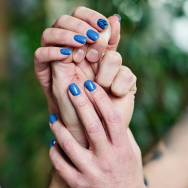Even when the intention is to express equality, speech can still reinforce gender stereotypes, because biases can slip through via subtle linguistic cues. For example, a subject-complement statement (SCS) such as “Girls are as good as boys at math” still transmits bias, as the statement suggests that boys are the standard against which girls are judged.
But new research published in Proceedings of the National Academy of Sciences (PNAS) found these stereotypes can be counteracted by a simple gesture. Two palms placed at the same height to indicate “equality,” accompanied by an SCS, resulted in children more likely to express egalitarian beliefs, compared with children who saw no gesture or an unequal gesture.
The study was led by Yihan Qian, a doctoral student in developmental psychology, and Lin Bian, assistant professor in the Department of Psychology and director of the Early Social Thinkers (EAST) Lab at UChicago. Susan Goldin-Meadow, the Beardsley Ruml Distinguished Service Professor in the Departments of Psychology and Comparative Human Development, co-authored the paper. The research was supported by Bian’s CAREER grant from the National Science Foundation.
“My lab studies stereotypes and biases, and we have found that many harmful stereotypes begin to form in early childhood,” Bian said. “Addressing these stereotypes and their negative impact means focusing on much younger children than most current efforts target. We’re working to create interventions that get to the root of these stereotypes early on.”
The power of language and gesture
Qian’s journey into this area of her Ph.D. research began during her time in the Master of Arts Program in the Social Sciences (MAPSS), where she worked in Goldin-Meadow’s lab before joining Bian’s lab as the lab manager.
In the last quarter of her master’s program, Qian took Bian’s seminar on the psychology of inequality, along with a reading class with Goldin-Meadow. In Bian’s course, they read a paper (Chestnut et al., 2021) showing that even statements that appear egalitarian on the surface can backfire and teach children nonexistent stereotypes about gender-neutral activities (e.g., “Girls are as good as boys at snapping.”). Simultaneously, in Goldin-Meadow’s course, the assigned readings catalyzed Qian’s thinking about the potential relationship between language and gesture modalities.
“I started to wonder which modality children are more likely to rely on when making social inferences,” she said. “If indeed they attended to one modality over another, maybe there is a room for potential intervention.” Qian roughly designed the study and brought the idea to both professors, who encouraged her to look deeper.
Who’s better at ‘yuzzing’? Exploring gestures and gender stereotypes
The researchers performed two studies. First, they introduced children to a planet, telling them it was located far away and there are girls and boys on this planet. Half of the children saw an actress reading a statement about the people on this planet—“Girls are as good as boys at yuzzing” (a made-up activity on the planet)—but without gesturing. The other half of the children saw the actress read the same statement while making the “equal” gesture (two palms placed at the same height).
The researchers then asked the children who they thought was better at “yuzzing.” Children who saw the actress not make any gestures chose the reference group (boys) as being better at yuzzing. However, children who saw the equal gesture while hearing the statement didn’t show favoritism toward either boys or girls.
“It's not a gesture we had seen before,” Goldin-Meadow said, referring to the “equal” gesture. “It's a gesture we imagined might have an effect on how people think about equality. The sentence sets up boys as the gold standard against which girls are measured. It’s a subtle message because the inequality is in the syntax of the sentence, not the semantics. What we’ve shown is that you can mitigate this subtle bias by displaying an equality gesture along with the sentence. Thus far, we’ve only used one gesture in our experiments––other equality gestures might work just as well.”
In the second study, the team looked to better understand whether the “equal” gesture, specifically, caused this effect, or if any gesture at all would have influenced or disrupted children's encoding of the verbal information. The second study had two conditions with two different gestures. The first included the SCS with the equal gesture, and the second presented an unequal gesture (the speaker’s hands placed the two groups at different heights when mentioning them).
The results of this second study replicated the findings of the first: Children seeing the unequal gesture chose the reference group (boys) as being better.
“Gestures are a powerful yet often overlooked modality that can not only support children’s learning but also play an incredibly important role in social contexts, such as mitigating stereotypes,” Qian said. “There is much more we can learn, not only from the things we unconsciously say with our words but also from the gestures we unconsciously make.”
Bian suggests that the findings of this research could, of course, be applied in educational contexts and everyday life. Teachers and parents may adopt the “equal” gesture to help counteract children's stereotype endorsement. “If left unaddressed,” Bian noted, “stereotypes can significantly influence a child’s interest and their future career decisions. While the equal gesture alone cannot fully resolve stereotyping, it offers a simple and easy-to-implement solution.”
The team is excited to continue research along these lines, with a new study underway that investigates the other side of the coin: whether biased gestures can transmit new stereotypes to children, even when language itself is unbiased.
Citation: ‘Gesture counteracts gender stereotypes conveyed through subtle linguistic cues.’ Qian, Goldin-Meadow, and Bian, Proceedings of the National Academy of Sciences, Jan. 21, 2025.
Funding: National Science Foundation
—Adapted from an article published by the Department of Psychology

